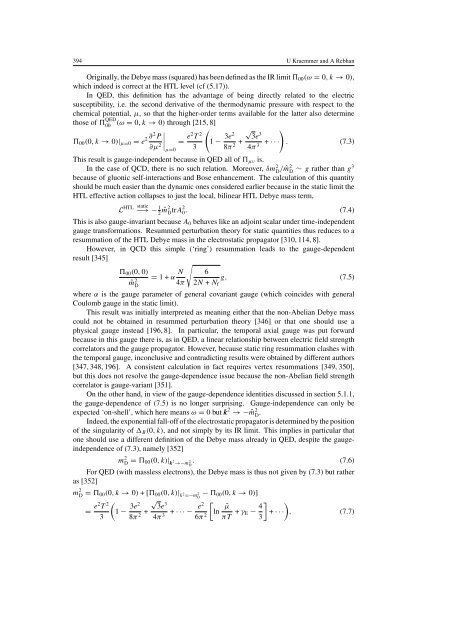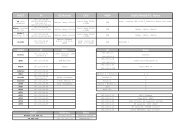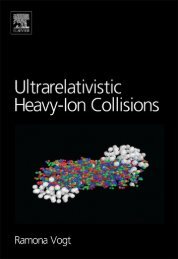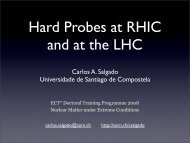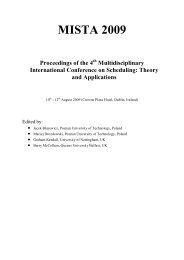Advances in perturbative thermal field theory - Ultra-relativistic ...
Advances in perturbative thermal field theory - Ultra-relativistic ...
Advances in perturbative thermal field theory - Ultra-relativistic ...
Create successful ePaper yourself
Turn your PDF publications into a flip-book with our unique Google optimized e-Paper software.
394 U Kraemmer and A Rebhan<br />
Orig<strong>in</strong>ally, the Debye mass (squared) has been def<strong>in</strong>ed as the IR limit 00 (ω = 0,k → 0),<br />
which <strong>in</strong>deed is correct at the HTL level (cf (5.17)).<br />
In QED, this def<strong>in</strong>ition has the advantage of be<strong>in</strong>g directly related to the electric<br />
susceptibility, i.e. the second derivative of the thermodynamic pressure with respect to the<br />
chemical potential, µ, so that the higher-order terms available for the latter also determ<strong>in</strong>e<br />
those of QED<br />
00<br />
(ω = 0,k → 0) through [215, 8]<br />
∣ ( √ ···)<br />
00 (0,k → 0)| µ=0 = e 2 ∂2 P ∣∣∣µ=0<br />
= e2 T 2<br />
1 − 3e2 3e<br />
3<br />
∂µ 2 3 8π + 2 4π + . (7.3)<br />
3<br />
This result is gauge-<strong>in</strong>dependent because <strong>in</strong> QED all of µν is.<br />
In the case of QCD, there is no such relation. Moreover, δm 2 D / ˆm2 D ∼ g rather than g3<br />
because of gluonic self-<strong>in</strong>teractions and Bose enhancement. The calculation of this quantity<br />
should be much easier than the dynamic ones considered earlier because <strong>in</strong> the static limit the<br />
HTL effective action collapses to just the local, bil<strong>in</strong>ear HTL Debye mass term,<br />
HTL static<br />
L −→ − 1 2 ˆm2 D trA2 0 . (7.4)<br />
This is also gauge-<strong>in</strong>variant because A 0 behaves like an adjo<strong>in</strong>t scalar under time-<strong>in</strong>dependent<br />
gauge transformations. Resummed perturbation <strong>theory</strong> for static quantities thus reduces to a<br />
resummation of the HTL Debye mass <strong>in</strong> the electrostatic propagator [310, 114, 8].<br />
However, <strong>in</strong> QCD this simple (‘r<strong>in</strong>g’) resummation leads to the gauge-dependent<br />
result [345]<br />
√<br />
00 (0, 0)<br />
ˆm 2 = 1+α N 6<br />
g, (7.5)<br />
D<br />
4π 2N + N f<br />
where α is the gauge parameter of general covariant gauge (which co<strong>in</strong>cides with general<br />
Coulomb gauge <strong>in</strong> the static limit).<br />
This result was <strong>in</strong>itially <strong>in</strong>terpreted as mean<strong>in</strong>g either that the non-Abelian Debye mass<br />
could not be obta<strong>in</strong>ed <strong>in</strong> resummed perturbation <strong>theory</strong> [346] or that one should use a<br />
physical gauge <strong>in</strong>stead [196, 8]. In particular, the temporal axial gauge was put forward<br />
because <strong>in</strong> this gauge there is, as <strong>in</strong> QED, a l<strong>in</strong>ear relationship between electric <strong>field</strong> strength<br />
correlators and the gauge propagator. However, because static r<strong>in</strong>g resummation clashes with<br />
the temporal gauge, <strong>in</strong>conclusive and contradict<strong>in</strong>g results were obta<strong>in</strong>ed by different authors<br />
[347, 348, 196]. A consistent calculation <strong>in</strong> fact requires vertex resummations [349, 350],<br />
but this does not resolve the gauge-dependence issue because the non-Abelian <strong>field</strong> strength<br />
correlator is gauge-variant [351].<br />
On the other hand, <strong>in</strong> view of the gauge-dependence identities discussed <strong>in</strong> section 5.1.1,<br />
the gauge-dependence of (7.5) is no longer surpris<strong>in</strong>g. Gauge-<strong>in</strong>dependence can only be<br />
expected ‘on-shell’, which here means ω = 0butk 2 →−ˆm 2 D .<br />
Indeed, the exponential fall-off of the electrostatic propagator is determ<strong>in</strong>ed by the position<br />
of the s<strong>in</strong>gularity of B (0,k), and not simply by its IR limit. This implies <strong>in</strong> particular that<br />
one should use a different def<strong>in</strong>ition of the Debye mass already <strong>in</strong> QED, despite the gauge<strong>in</strong>dependence<br />
of (7.3), namely [352]<br />
m 2 D = 00(0,k)| k 2 →−m . (7.6)<br />
2 D<br />
For QED (with massless electrons), the Debye mass is thus not given by (7.3) but rather<br />
as [352]<br />
m 2 D = 00(0,k → 0) +[ 00 (0,k)| k 2 =−m 2 − 00(0,k → 0)]<br />
D<br />
√<br />
= e2 T 2 (1 − 3e2 3e<br />
3<br />
[<br />
3 8π + e2<br />
+ ···− ln ˜µ<br />
2 4π 3 6π 2 πT + γ E − 4 ] )<br />
+ ··· , (7.7)<br />
3


